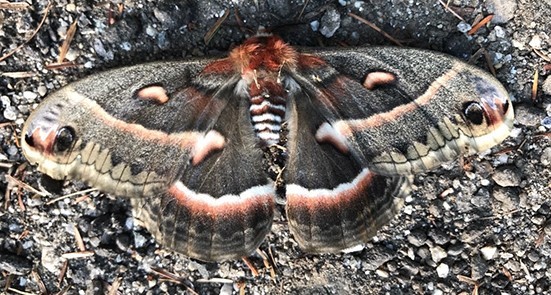 Night-flying Beauties - Moths
The world of moths is fascinating. Yet many people only see them on late summer evenings as they flutter around a porch light or tap at the window of a light-filled room. With National Moth Week just a few days away - July 17 through 25 - now is the time to become a "Moth-er". National Moth Week celebrates the beauty, life cycles, and habitats of moths. Moth-ers of all ages and abilities are encouraged to learn about, observe, and document moths in their backyards, parks, and neighborhoods. Celebrating its 10th year, from its beginnings as an expansion of popular moth nights in Brunswick, NJ to a statewide event, it evolved to a national week, then quickly into an international citizen science project.
Luna moth photographed at Grafton Notch State Park by Tim Healy, Park Manager.
Interesting Facts
- Moths are among the most diverse and successful organisms on earth.
- About 11,000 kinds of moths live in the United States. Scientists estimate there are 150,000 to more than 500,000 moth species worldwide.
- Though we typically think of moths as night flyers, many species of moths are active during the daytime. The Hummingbird Hawkmoth is one of them.
- Moths and butterflies are the only insects that have scales on their wings.
- Most moths are harmless to humans, but a few can be harmful or damaging:
- The browntail moth, as a caterpillar, has hairs that can cause a skin rash on humans like that caused by poison ivy and difficulty breathing when inhaled. Browntail moths were accidently introduced into Somerville, Massachusetts from Europe in 1897. By 1913, the insect had spread to all of the New England states and New Brunswick and Nova Scotia.
-
Clothes moths may be found in closets feeding on woolen jackets, silk dresses, leather goods, and felt hats. But it is not the adult that feeds on these items, but the caterpillar (the larval stage of the moth) that does all the damage.
- Moth antennae are typically feathery or threadlike, while butterfly antennae are generally clubbed.
- Look for moths at rest holding their wings open; while butterflies at rest hold them up together at right angles to their back (thorax).
 |
Promethea silkmoth photographed in Maine by Jocelyn Hubbell.
Activities for Children and the Young at Heart
- Get involved with National Moth Week:
- Get kids involved by starting with the National Moth Week Kids' Page.
- Learn how to find and observe moths.
- Observe and photograph moths during National Moth Week.
- Submit your high resolution photos at the National Moth Week data page.
- Little is known about the caterpillar (larval stage) of most moths. You can add to the body of knowledge about both moths and butterflies by sending your photos with sighting information to the database at www.butterfliesandmoths.org.
- Download a county-specific species checklist for your area, courtesy of butterfliesandmoths.org., and then look them up in their image gallery.
- Make a list of the daytime active and nighttime active moths in your area. Then you'll have a list for both day and night-observations. Tip: Use one sheet of paper and write the day list on one side and the night list on the opposite side. Illustrate with drawings of the moths you see, or want to see.
- If you would like to use a field guide, consider my favorite: Peterson Field Guide to Moths of Northeastern North America by David Beadle and Seabrooke Leckie. Support your local bookstore or look for it at your local library.
Share Nature Note with your friends, family, teachers, scouts, and anyone you think might be interested. Here is how they can sign up for a free subscription:
Read back issues online.
Suggest a topic by email; put Nature Note in Subject line and email Jocelyn Hubbell.
|